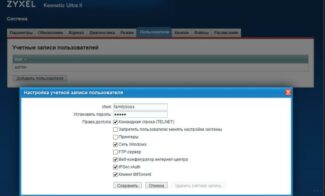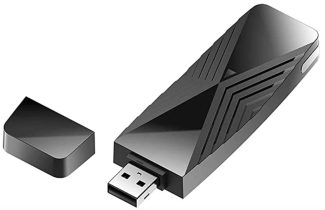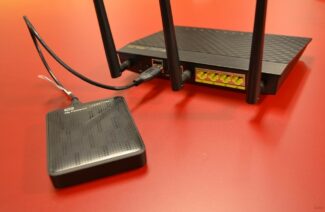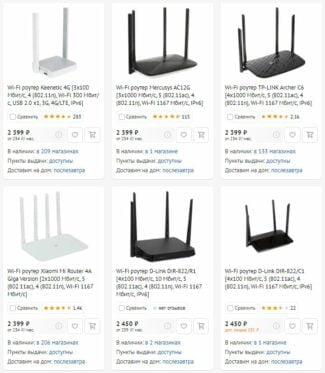Modern mobile devices are often equipped with large storage capacity, 128, and sometimes even 256 or 512 GB. But to increase this capacity a special device can be used – a wireless flash drive, which does not require a physical connection. The same drive, connected via Wi-Fi, can be used with a desktop or laptop computer. And one of the most popular models in 2022 is the SanDisk Connect Wireless.

USB flash drive with Wi-Fi: connecting via WiFi to the pocket cloud

Hello dear friend! Today we will talk and tell everyone about the Wi-Fi stick. Once upon a time, when I was told about this gizmo, I immediately imagined an ordinary WiFi module, which allows to connect to a wireless network – but how wrong I was. Basically, you can already tell from the name what a WiFi stick is. In general, it is a storage device that can be used simultaneously as a normal flash drive – by inserting it into the USB connector. As well as a cloud drive, which can be accessed via wi-fi.
Let's look at some additional features:
- Works with all operating systems, even Android and iOS.
- There is a dedicated app that makes it easy to work and manage your files.
- It is possible to stream videos, pictures, sound from multiple devices at once.
- The application has the ability to make backups of a folder or individual files. For example, you can organize a backup of important files, videos, photos, etc.
And so first we will look at the model from the company "Sandisk", and then at the very end I will say a few more words about the Wi-Fi flash drive Uniscend Cloud. In general, they are about the same, so you can view a full review of both.
Appearance and features
The maximum size to date is 256GB. It is convenient enough, you can drop off extra files, pictures, videos from your phone, tablet, laptop or computer, which are in the same wireless network. It can work anywhere: in the woods, at school, at work, at friends' houses. Anyone can connect and play any content saved on disk.

The full name sounds like – SanDisk Connect Wireless Stick. Externally it looks like a normal Flash-drive and the size is the same. On the front of the USB connection you can see a WiFi icon, which symbolizes the wireless connection. There is a power button which turns on the wireless module itself.

I immediately tested the data transfer speed of the port. I wasn't surprised, but the speed wasn't great because of the USB 2.0 interface. You can connect to the flash drive using a special application SanDisk Connect. You can download it from:
Usage Scenarios
Why do I need a flash drive with Wi-Fi at all? Let's discard applications invented for advertising purposes and think about what really comes in handy. If we're talking about security, it's primarily the ability to work with any data without saving it locally. On your work smartphone or laptop, there simply won't be anything that can be turned against you. Even if your gadget falls into the wrong hands, the compromise stays on the flash drive.
It's basically your own cloud that you can carry around with you. Remember the immortal lines: "I pull it out of my wide trousers…"? Well, this flash drive does not need to be taken out! You can throw it in a backpack or hide it somewhere in the office, use it or send clean content to others without giving up the drive.
Another use case is when there is not enough space on mobile devices. Some smartphones do not have a memory card slot. If necessary, they connect flash drives via the microUSB connector, but this is not very convenient, and USB-OTG support may not be. SanDisk Connect will not be a panacea because of the short battery life (up to four and a half hours), but it allows you to store gigabytes of files that you do not need access to often.
If you don't have a router, a wireless flash drive can be used to connect devices over Wi-Fi. Just connect them to the same network with a name like SanDisk Connect UID , and they can share files wirelessly. This is especially handy at all sorts of outdoor events where you need to quickly share data with a bunch of people.
Exterior
The SanDisk Connect flash drive with wireless is available in capacities from 16GB to 256GB. For our tests, we bought the 32-gigabyte model. The larger versions are not formatted to FAT32 but to the proprietary exFAT system. Not all devices support it. Changing the logical partitioning, on the other hand, would have affected the tests. The youngest model could have been cut in something else, so we decided not to take any chances.
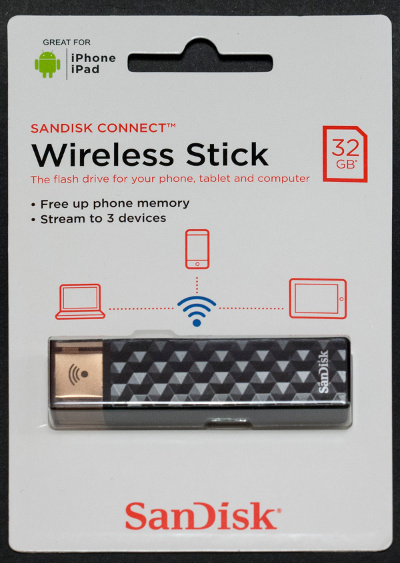
The user has 29.6 Gbytes available, 0.04 Gbytes of which is taken by the content recorded by the manufacturer. That's a sample of photos, music files and one video.
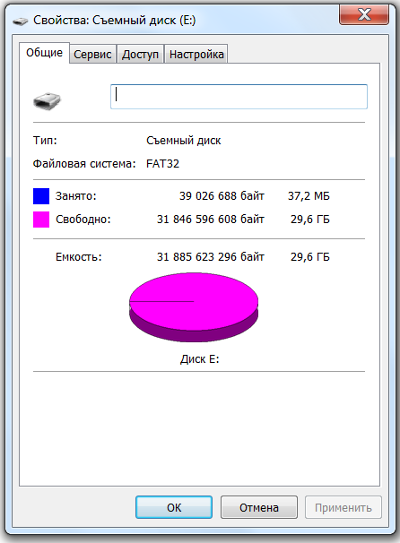
SanDisk Connect Overview
The SanDisk Connect Wireless Stick is available in 16GB to 256GB capacities. Versatile models up to 64GB are formatted in FAT32, which is supported by any modern device. The larger versions only have exFAT support.
Appearance
Visually, the flash drive does not differ much from the usual flash drives. The case is made of black plastic with a matte surface and a hexagonal pattern. In the middle of one of the hexagons there is an indicator of operating modes and low battery. On the side edge is a button to enable wireless data transfer. On one side there is a standard USB connector covered by a transparent cap. On the opposite side there is a hole for a lanyard or keys.

Disassembling the flash drive, inside you can see the built-in battery. The battery capacity – 380 mAh, operating voltage – 3.7 V. Dimensions – 16h52 mm. According to these dimensions, you can easily find a replacement battery if it fails. Dismantling also allows you to replace the drive, which is used as a memory card microSD UHS Speed Class 1 of the appropriate size.
Model Specifications
- capacity16, 32, 64, 128, 200 or 256GB
- connectivityConnectivity : via USB 2.0 (which is used for charging) or Wi-Fi;
- supported platforms: Android 4.2, iOS 8.0, Mac OS 10.6, Windows Vista and later;
- Dimensions20.8×7.8×1.2 cm; Dimensions: 20.8×7.8×1.2 cm
- operating temperature: 0-45 °C;
- operating range2.4 GHz (802.11n standard, supports speeds up to 80 Mbps).
The model supports simultaneous connection of at least 8 devices. Video transmission is possible only to 3 gadgets, the speed is enough to broadcast movies with a resolution of 420p-720p. The range is 50m if there are no obstacles in the way of signal.
Similar wireless USB drives
The model has several Chinese analogues. Among them is a wireless storage Uniscend Cloud.. It differs in support for USB 3.0 , which will provide an advantage for the physical connection. Wireless transmission speed is similar. The volume is 32 GB, working time without recharging – 3 hours. The cost of buying the gadget is comparable to that of the SanDisc.

Leef iBridge Air wireless storage device is designed specifically for use with iphones or iPads Leef iBridge Air. Data transfer speed via Wi-Fi is similar, when connecting to a PC – higher by several times (standard USB 3.1), battery life reaches 6 hours. The capacity of flash drives Leef – from 16 to 256 GB. The disadvantage of this gadget – high compared with models SanDisk price.

The SanDisk Connect model is a versatile solution that allows you to partially replace your router and even the cloud, where you can store a large amount of information. With its help, you can easily share files between several devices, stream videos to 2-3 gadgets, make backups of photos.
The storage device looks attractive, does not take a lot of space, long enough to work without recharging. But it also has a number of drawbacks – low data transfer rate, lack of support for external power supply for wireless data transfer.
Standalone operation
The manufacturer does not specify the battery capacity of the Wireless Stick, but its volume, given the modest size of the device itself, is obviously not large. In wireless mode, the gadget can work for about 4.5 hours – quite enough for watching a couple of movies. Wireless Stick can be charged only from the USB port and takes two hours. During this time, it is not possible to use the wireless functions of the device.
The bottom line is .
The SanDisk Connect Wireless Stick is a great idea, how to improve and "modernize" the ordinary flash drive. So far it is more of a flop with a number of obvious shortcomings: the gadget lacks USB 3.0 support and a little more autonomy. Nevertheless, it is certainly more convenient than traditional flash drives and provides the user with an alternative to cloud services that has its obvious advantages. The Wireless Stick costs from $30 for the 16GB model to $100 for the 128GB model.
Read More:

